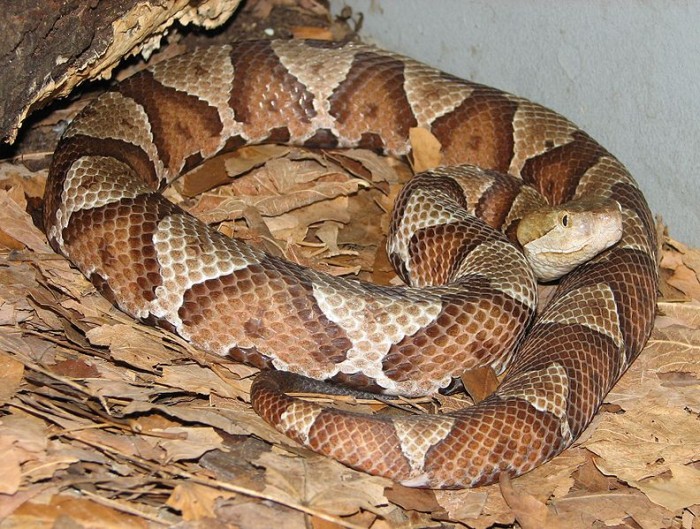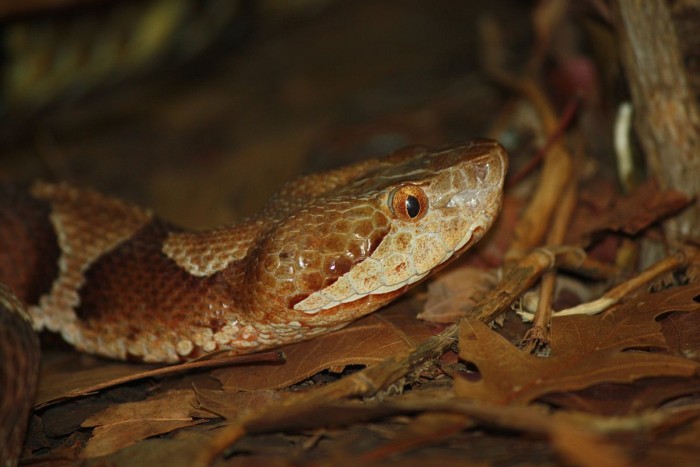Snake Bite (Envenomation) of Dog or Cat by Copperhead
With the turn of Veterinary Medicine towards ‘not using steroids’ in animals, I’ve watched delayed-type-hypersensitivity reactions, and Addisonian-crises dogs die in the care of knowledgeable Emergency Clinic and Specialty Hospital clinicians. I’ve seen Copperhead bites cause unnecessary damage, and take weeks to heal.
They’re taught that steroids will open the dogs and cats to co-morbidities (infections). (Without information that supports the use of antibiotics might somehow mitigate that? That withholding steroids will likely kill the pet and eliminate all those risks tomorrow?)

I don’t know if it is the real clinical care specialists (OR the MBA’s at corporate) actually making that decision. Or if the Vets just think steroids are “so 1990”.
In any event, the use of steroids in the management of many types of cases once thought to be ‘steroid cases’ is being avoided, and pets are dying.
For example, a Copperhead bite that went to the emergency clinic and was denied steroids. A VERY large amount of tissue was sloughed, and it took WEEKS to heal.
The use of Fluids, Steroids, DMSO and an insulin poultice, would have abbreviated that CONSIDERABLY but only one of the above would be used in today’s, “modern” and “erudite” clinical settings.
To speed-heal a lesion with granulation tissue; a mixture of raw insulin with NeoSporin antibiotic ointment is POWERFUL healing. But again, NOT IN civilized, proper, MODERN MEDICINE!
ANTIBIOTICS are important!!! See below.
Here is how I treat MY PATIENTS with Copperhead bite. If you ask your clinician to consider these modalities I am sure there will be resistance to these ‘Neanderthal’ methods but I have my dogs back in the yard FAST and healthy.

Copperhead bites are an active process and the Copperhead has to ‘think’ about pushing venom from it’s glands. A good, square bite from an adult snake can cause considerable damage. The venom of the copperhead is a NECROtoxin, not a neurotoxin. So the venom DISSOLVES tissues. The idea being that the mouse it struck is already dead and auto-digesting by the time the snake consumes it.
So the venom DISSOLVES tissues.
When your pet gets HIT by a copperhead, knowing the location of the strike and the ‘quality’ of the strike is important.
A pair of holes* will appear at the site of the bite QUICKLY and the tissues in the area will be changing color and oozing within less than 2 hours. HURRY to a Veterinary hospital and find an OLD vet.
*or just one hole
Step one: Overall assessment of the pet.
- Is it really Copperhead bite?
- Is the pet breathing alright?
- How is the cardiovascular system? Is the pet pale? Shocky?
- Where is the lesion? Are there more than one lesion?
Step two:
Collect the customers financial data, give them a $1,200 to $1,800 estimate and collect bloodwork and urinalysis. NO NO NO sorry, that’s CORPORATE vet medicine…..In private practice, the vets decide what to do, and you start treatments first, not diagnostics and money questions.
Step two of Copperhead Snakebite:
I drop a fluid line under the skin* and give all the fluids that my calculations dare to let me. (Of course if the pet is cardiac-insufficient, I’m cautious about fluid-overload). I don’t waste time with catheter-selection and placing an IV catheter at this time. Yes of course it makes vets feel important to run around and make these ‘weighty decisions’ and the dramatic music in my head is LOUDER when I’m doing ‘fancy’ medicine but the dog ought to start fluids immediately.
In private practice, the vets decide what to do, and you start treatments first, not diagnostics and money questions.
Step three:
I find and SHAVE THE HAIR OFF of any obvious or suspected strikes. I then apply 99.9% pure DMSO (gel, liquid) to these lesions. They will get VERY warm as you apply the compound. (We wear gloves to avoid exposure to myself and my staff. A formality)
To keep DMSO from wiping off so quickly, you can ‘plastic bag’ or plastic-wrap the appendage or area and apply a wrap to hold the plastic in place. Swelling is due, so I don’t make the wrap very tight.
There’s always the option to give antihistamines and diphenhydramine is available in an injectable form which is fine.
Step four:
I use an IV steroid. I know it’s heresy and ‘archaic’ and according to some textbooks it ‘doesn’t work’ in theory. I have also noticed that vets who are buying into the idea that there is no grounds for the use of steroids are losing more patients and making more money on protracted recoveries, so I’m not sure what’s up with that.
Step five:
- Have a talk about ‘skin sloughing’ with the owner. A certain, small amount of skin will die over and around the site of the Copperhead strike. More will harden, turn purple and brown, and peel out, if the pet got steroids fluids and DMSO later. LESS will slough if the dog got DMSO, fluids and steroids QUICKLY.
- Have a talk about ‘secondary infections’. What happens is that the tissues in the vicinity of the bite will dump ‘water’ into the extracellular area as part of the inflammatory process. The area becomes ‘waterlogged’ and at 101.6 degrees in damaged tissue, with all that plasma and serum and juice, GERMS have a party. This is ESPECIALLY true with a good, square bite to the muzzle of the dog. This is why I am AGGRESSIVE with two, decent-spectrum antibiotics, as much as I HATE using antibiotics.
This is why I am AGGRESSIVE with two, decent-spectrum antibiotics, as much as I HATE using antibiotics.
OPTIONAL
CAUTION: You can use DMSO under the skin* and also, IV. Nothing has been published about this with specific indication but a LOT has been published about the IV route of administration and it’s impacts on ‘reperfusion injuries’. If I were YOU I’d skip it.
But, I’d recommend it to MY client in Copperhead bite.
The strongest you can make your DMSO infusion for subcutaneous use is 12cc of DMSO 99.9 in 1 LITER of fluids. That can be run under the skin without discomfort or damage. Straight DMSO burns like a beesting whether SC or extravasation during IV admin. Repeated IV administration will cause thickening of the vein you give it in. Running DMSO alongside fluids IV only, superheats the vein. So we needed an alternative and we came up with dilution and administration as above. 12ml/1000ml and SC admin.
So we needed an alternative and we came up with dilution and administration as above. 12ml/1000ml and SC admin.
Given intravenously, if it’s a ‘last resort’ you can use DMSO undiluted






